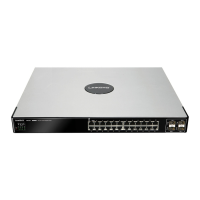Managing Device Information
Managing Stacks
Cisco Small Business SFE/SGE Managed Switches Administration Guide 23
2
connection to the stack via the new Unit 4. The old Unit 4 and the new Unit 4
appear to the Master unit as two new, manually numbered units trying to
simultaneously join the stack. Therefore, both units are shut down, and thus
Units 6, 7 and 8 remain shut down.
What happens if the replacement unit is inserted into the stack (in the same
position as Unit 3) after first powering off all units and then simultaneously
powering on all units?
If all units in the stack are reset, the Master unit performs Topology
Discovery during the software boot, revealing that there are two duplicate
Unit IDs (old and new Unit 4). Since both units are manually numbered, both
units are shut down by the Master unit. This, in turn, again leaves Units 6, 7
and 8 disconnected from the Master unit, thus shutting them down also.
• A stack is initially configured in a chain topology as follows:
Unit 8—Unit 5—Unit 1—Unit 3—Unit 4—Unit 6—Unit 7—Unit 2
Unit 1 is the Master and Unit 2 is the Backup. Unit 3 fails. What happens?
The failure of Unit 3 disconnects Units 4, 6, 7 and 2 from the Master unit.
Backup Unit 2 senses the loss of the Master and automatically becomes the
Master of a stack comprised of Units 2, 4, 6 and 7. Unit 1 remains the Master
of the now reduced stack, consisting of Units 1, 5 and 8. Thus the failure of
Unit 3 has split the original stack into two smaller stacks. However, while the
two stacks continue in operation, this situation may create problems on the
network because Unit 2 and Unit 1 have the same Master configuration files.
The significance of this is that both stacks share the same IP address,
making network communication with either stack ambiguous.
Managing Stacks
The
Stack Management Page
allows network managers to configure stacking
members on the device and determine to either reset the entire stack or a specific
device. Device configuration changes that are not saved before the device is reset
are not saved. If the Master unit is reset, the entire stack is reset.
To open the
Stack Management Page
:

